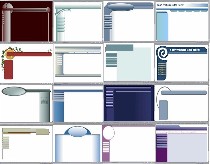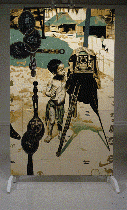
Post by Doug Witmer
[Editor’s note: We’ve been to several art events these past two weeks in which globalization of art has been a theme, including the Arthur C. Danto lecture and the Jorg Immendorff symposium, both posted. The Arcadia Works on Paper opening was part of what inspired this thoughtful post.]
I hardly read the art magazines I subscribe to. One of the main things I seem to do with them is just look at pictures and the ads for different galleries (left, an ad in Art in America). Now I’m a new father and for the past few months my way of visiting galleries has been letting my fingers do the walking across my computer keyboard.
Lately I’ve been really aware of how many gallery (and museum) ads, publications, websites, and actual spaces are so similarly designed. It’s making me begin to wonder…where did this “taste” come from?
 And by extension, I’m beginning to think about the possibility that art being made today is conditioned to be part of this “design” continuum. And I (call me paranoid) have a fear that when I work, I might be making semi-conscious micro-choices that are based on an assumption of these white boxes as an initial venue. And what does that do to the work (shown, Web page templates)?
And by extension, I’m beginning to think about the possibility that art being made today is conditioned to be part of this “design” continuum. And I (call me paranoid) have a fear that when I work, I might be making semi-conscious micro-choices that are based on an assumption of these white boxes as an initial venue. And what does that do to the work (shown, Web page templates)?Do folks think there is some kind of identifiable “international style” of art? Or maybe more of an “international attitude” expected of artists?
 The idea of regionalism, suggested to me in my art upbringing as not necessarily a positive thing, now becomes interesting. I was thinking about that as my baby and I tried to see the art at the opening of the Arcadia works on paper biennial (shown, Eliseo Art Silva’s “Boy With Camera”). Does regionalism exist anymore? Is this a good or bad thing? If someone were to describe the regionalism of Philadelphia, what kind of words might they use? Is it possible or desirable to identify oneself as being part of any regional milieu?
The idea of regionalism, suggested to me in my art upbringing as not necessarily a positive thing, now becomes interesting. I was thinking about that as my baby and I tried to see the art at the opening of the Arcadia works on paper biennial (shown, Eliseo Art Silva’s “Boy With Camera”). Does regionalism exist anymore? Is this a good or bad thing? If someone were to describe the regionalism of Philadelphia, what kind of words might they use? Is it possible or desirable to identify oneself as being part of any regional milieu?
–Philadelphia artist Doug Witmer is in the Repetition and Transformation exhibit at the Philadelphia Cathedral, up until Feb. 22.









